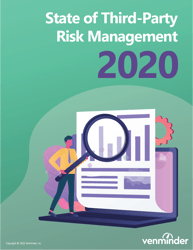-

- Request a demo
- Community
- Resources
- HOW-TO
- ABOUT VENMINDER
- FAQ
-

Third-Party Risk Management 2020
New survey findings just released show third-party risk trends, insights and challenges for 2020.
DOWNLOAD NOW
Resources
- Company
- OVERVIEW
- NEWS
-
Customer Success Stories
Clients love Venminder because the tools are user friendly and you have an entire firm behind you to manage the everyday risks associated with third parties.
READ STORIES
Company
- Services
- OVERVIEW
- MANAGED SERVICES
-
Outsourcing Benefits
Vendor management oversight is now recognized as a unique discipline which you can successfully outsourced.
LEARN MORE
Services
- Software
- Software
- Services
- OVERVIEW
- MANAGED SERVICES
- Vendor Vetting
- Contract Compliance
- Document Collection
- Financial Health Assessment
- SOC Assessment
- BCP/DR Assessment
- Information Security Assessment
- Point-In-Time Cybersecurity Assessment
- Ongoing Cybersecurity Monitoring
- Vendor Risk Monitoring
- Policy/Program Template & Consulting
- Regulatory Compliance & Ops Assessment
- Virtual Vendor Management Office
- Company
- Resources
- Community







